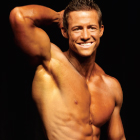 [Download a free issue of Iron Man Magazine for iPhone and iPad]
[Download a free issue of Iron Man Magazine for iPhone and iPad]
Physique—most people haven’t heard that one in a while; it’s so old school. Back in the ’50s, ’60s and ’70s the word had a direct connection to physical culture—and for that reason it means so much more than word bodybuilding.
Physique has always been a part of bodybuilding, but it has the connotation of a proportionate body, a muscularly impressive but more athletic physique. Over the years, as the competitive arena has lost that connection to the old-school idea of physique, the importance of proportion in judging the male physique onstage has been diminished.
Bodybuilding and physique conjure up two completely different images for the average gym member. Most can identify with the idea of building a physique but not with building a bodybuilder’s physique. The bodybuilder, as they perceive him, is a huge, half-naked guy hitting muscle shots onstage—definitely not a vision the majority of weight trainers identify with.
On the other hand, physique suggests athletic grace—developed, yes, but not at the expense of line and proportion—more like the physiques of the ’50s and ’60s, like Steve Reeves. Younger trainees probably have no idea who Steve Reeves is, but he is the physique ideal.
As long as artists have been creating idealized human forms as statues and paintings, there has been a hunger for and appreciation of the proportionate, muscular athletic form. Even so, as competitive bodybuilding has evolved into a size war, fewer men and women have aspired to that look. That in turn has inspired an evolution.
It started with women’s bodybuilding and the emergence of figure competitions, in which size and definition were not the deciding factors. In fact, the judging criteria penalized the very attributes that had come to define the competitive female bodybuilder. That attracted many women, a few who had the potential to be a Rachel McLish, the first Ms. Olympia and the woman who changed the way women saw themselves. Figure was for the woman who had more of a traditional “bikini body.” Curves were back onstage, and even more so with the advent of bikini competitions, which require even less of a muscular look.
All of the competitors in these evolving events used the tools of bodybuilding but never identified themselves as bodybuilders because the perceived definition of bodybuilding has become limited by its winners. Now, finally, and in a very exciting way, the word physique has reentered the competitive arena for men.
We will never change the way the general public perceives bodybuilding, but by creating a new division, men’s physique, we have spurred a resurgence of interest in competing. The numbers of entries in figure, bikini and physique are now the dominant force at events. The three divisions have been a kind of rediscovery of what bodybuilding was and could have been and have given thousands the inspiration to step onstage, fulfill their dreams and enjoy the satisfaction of achievement—and I’m glad to see it! IM




















You must be logged in to post a comment Login